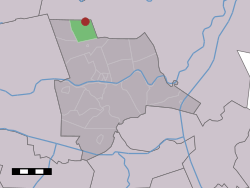Ommerschans
| Ommerschans | |
|---|---|
| Hamlet | |
 |
|
 The village (dark red) and the statistical district (light green) of Ommerschans in the municipality of Ommen. |
|
| Coordinates: 52°35′9″N 6°24′21″E / 52.58583°N 6.40583°ECoordinates: 52°35′9″N 6°24′21″E / 52.58583°N 6.40583°E | |
| Country | Netherlands |
| Province | Overijssel |
| Municipality | Ommen |
| Population | |
| • Total | 290 |
| Time zone | CET (UTC+1) |
| • Summer (DST) | CEST (UTC+2) |
Ommerschans is a former bulwark in the Dutch province of Overijssel. It is a part of the municipality of Ommen, and lies about 16 km south of Hoogeveen.
The statistical area "Ommerschans", which also can include the surrounding countryside, has a population of around 290.
The Ommerschans was a fortress built in 1628 as part of a defence line to defend the northern provinces of Groningen and Friesland from the marauding count Hendrik van den Bergh (in Spanish service) after the expiration of the Twelve Years' Truce.
Its defences were strengthened again in the middle of the 17th century to defend against a possible invasion from the east. Nonetheless the fortress was captured without any resistance when the Catholic bishops Bernhard von Galen of Münster and Maximilian Henry of Cologne invaded in 1672, the so-called rampjaar (or disaster year) that started the Franco-Dutch War. The 146 musketeers and 55 pikemen stationed at Ommerschans fled north, only to return later that year when the bishops retreated after their failed siege of the northern city of Groningen.
Under pressure from the citizens of Ommen and after the Peace of Utrecht of 1713, the fortress was closed down in 1715, only to be reinstated as a fortified arsenal in 1740 when war reignited in Continental Europe. During the Patriot Revolt of 1787, militias from Zwolle, Kampen and Vollenhove conquered and pillaged Ommerschans, stealing all its weaponry to help them in their paramilitary struggle against the regime. The fortification became abandoned and would never again be used for military purposes.
...
Wikipedia
